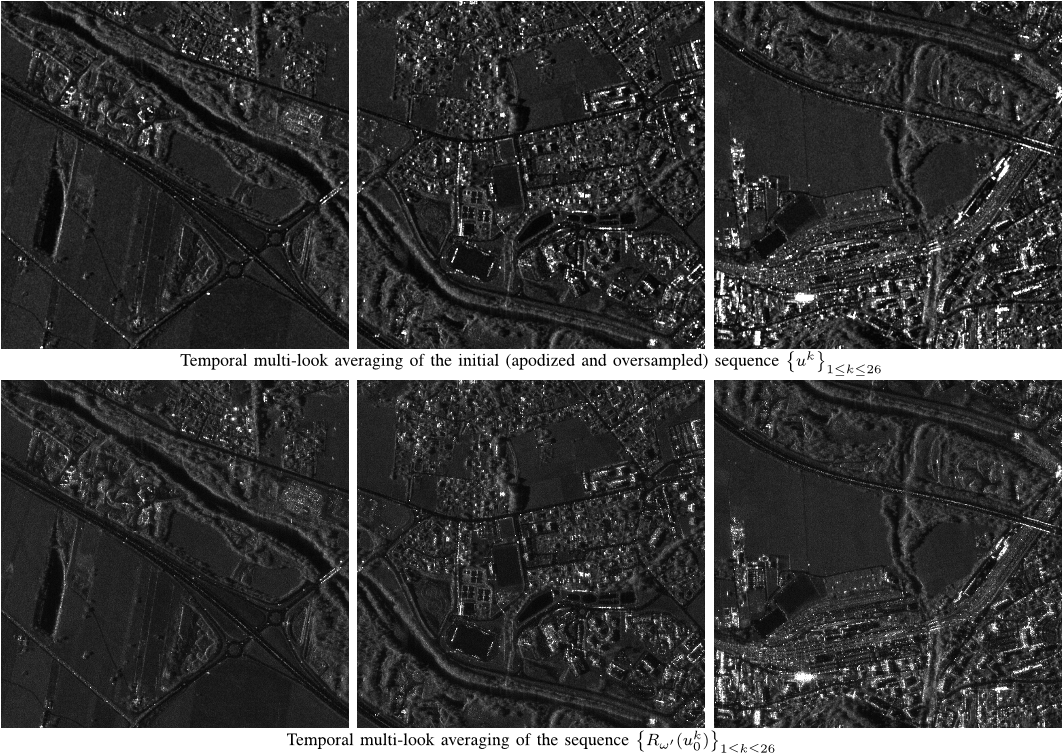




Did you find this useful? Give us your feedback














![Fig. 12. Quality of the speckle plus target decomposition. We synthesized a set C0 containing ten targets (x0, y0, A0) with random center position (x0, y0) ∼ U[0,100]×[0,100], and random complex amplitude A0 = eiϕ, such as ϕ ∼ U[0,2π]. The image S0(C0) containing those targets was corrupted by a stationary speckle with reflectivity 2σ2, by adding independently to the real and imaginary parts of S0(C0) a Gaussian noise with zero-mean and standard deviation σ. Then, we used Algorithm 4 (with parameters setting K = 25, NT = 20 and ε = 1) to compute from the image the set of detected targets C . The same experiment was repeated one thousand times for different noise level σ. On the second column of this Table, we display the average number of extracted targets, on the third column, the average mean square error (MSE) between S0(C0) and S0(C ), and on the last column, the corresponding PSNR (using PSNR = −10 · log10(MSE)).](/figures/fig-12-quality-of-the-speckle-plus-target-decomposition-we-3r1tg7zw.png)







226 citations
72 citations
...In this paper, the noisy TerraSAR-X images are decorrelated using the method proposed in [40] and the Sentinel-1 images are decorrelated by resampling because of its special acquisition model (the beam both steering in range direction and steering from backward to forward in azimuth direction)....
[...]
57 citations
...Whitening the spectrum [18], [25] or down-sampling the image...
[...]
...man’s fully developed speckle model generally assume an absence of spatial correlations [17], which is not the case in actual SAR images synthetized by space agencies [18], [24]....
[...]
33 citations
17 citations
...For instance, a tailored procedure, decomposing single-polarization SAR imagery in speckle dominated areas and point targets, was proposed in [33]....
[...]
9,380 citations
...Under that viewpoint, the CLEAN algorithm corresponds to the mere matching pursuit [37] while the RELAX algorithm is closer to the orthogonal matching pursuit [38]....
[...]
6,712 citations
...It follows that Uc0 is a band-limited signal which can be reconstructed exactly (neglecting sensor noise), according to the Shannon-Whittaker Sampling Theorem [30], [31], provided an infinite number of its samples {Uc0 (k · δr, ` · δaz)}(k,`)∈Z2 are observed at regularly spaced locations, with steps δr ≤ 1 along the range direction and δaz ≤ 1 along the azimuth direction....
[...]
...Sampling Theorem [30], [31], provided an infinite number of its samples {U 0 (k · δr, ` · δaz)}(k,`)∈Z2 are observed at regularly spaced locations, with steps δr ≤ 1 along the range direction and δaz ≤ 1 along the azimuth direction....
[...]
5,415 citations
...Rather than locally selecting the best suited apodization, spectral super-resolution techniques (Capon [8] or APES [9]) are applied to improve the localization of point targets....
[...]
4,607 citations
...Under that viewpoint, the CLEAN algorithm corresponds to the mere matching pursuit [37] while the RELAX algorithm is closer to the orthogonal matching pursuit [38]....
[...]
3,963 citations
...In particular, many works are devoted to identifying weak targets or moving targets [11]–[15], under foliage targets [16], using polarimetric data [17]–[19] or interferometric data [20], [21]....
[...]
It would be also interesting to investigate the possibility to design SAR image processing models that would rely on the two components jointly.
Their revisited CLEAN procedure relies on an efficient sub-pixellic target detection criterion based on the so-called a contrario methodology [43], which leads to a well justified stopping criterion and an accurate control of the false alarms.
Initialization: precompute the horizontal and vertical translations of u0, that is, compute for all t ∈ T, uxt = U0(ω − (t, 0)) and uyt = U0(ω − (0, t)).
Compared to the classical statistical decision theory, the a contrario framework presents the advantage to get rid of the design of a H1 hypothesis, making the a contrario algorithm less sensitive to the modeling choice for the structures that the authors want to detect.
C the recombination of C into discrete Diracs on the grid ω′, which is defined by∀(x′, y′) ∈ ω′, Dω′(C )(x′, y′) = ∑(x,y,A)∈CAδπω′ (x,y)(x ′, y′) , (22)where πω′(x, y) = argmin(x′,y′)∈ω′ ‖(x − x′, y − y′)‖ denotes a projection of (x, y) over ω′, and δπω′ (x,y)(x ′, y′) is defined by∀(x′, y′) ∈ ω′ , δπω′ (x,y)(x ′, y′) = { 1 if (x′, y′) = πω′(x, y) 0 otherwise,so that δπω′ (x,y) simply represents a discrete Dirac centered at the position πω′(x, y) ∈ ω′.
due to the sampling, the total amplitude of the target can be smeared in the vicinity of its center (this is the sidelobe effect) which makes difficult the estimation of the reflectivity of its surrounding area.
Under this model, the continuous signal Uc0 : R2 → C, before sampling, can be modeled as the convolution between the continuous latent scene and the impulse response.